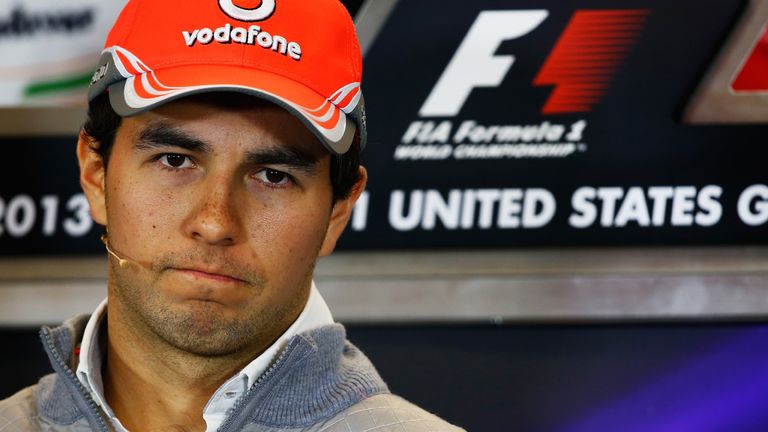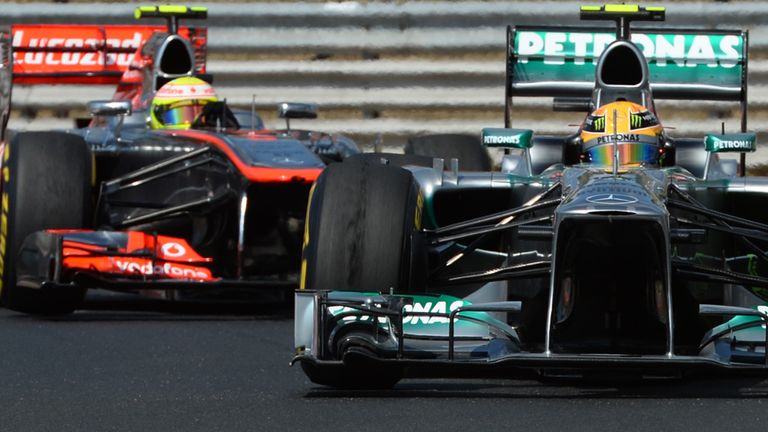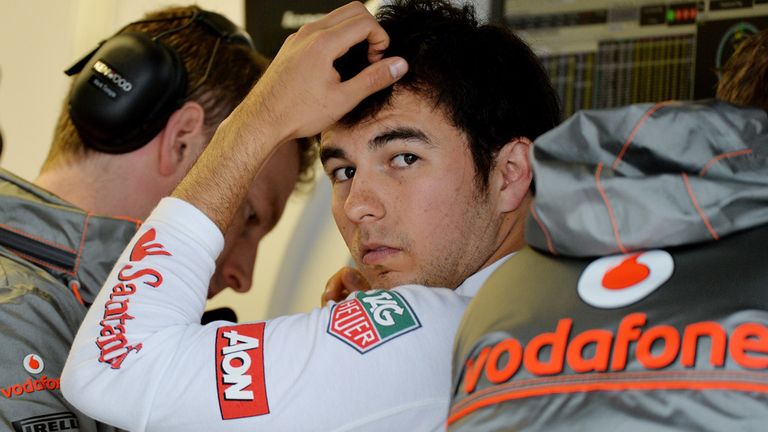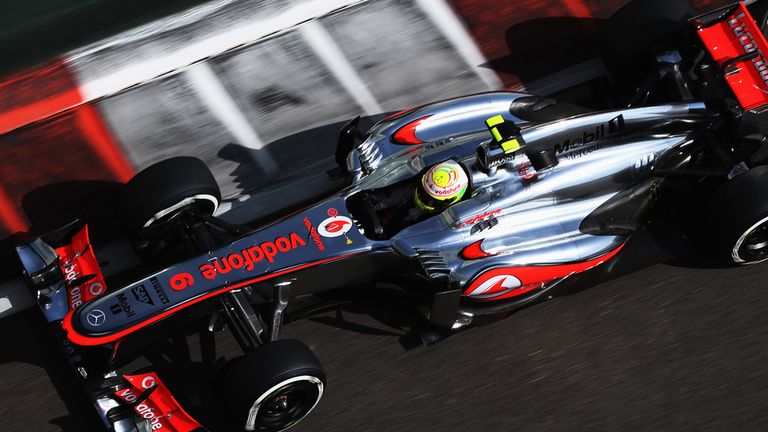Sergio Perez recalls McLaren woe but ready for top-tier return
Can Sergio succeed in 2017 where he failed in 2013?
Thursday 23 June 2016 10:05, UK
Sergio Perez has opened up on his nightmare season at McLaren, a year which ended in the Mexican being ruthlessly dropped but which he now believes has made him into a stronger and better driver.
Hired as Lewis Hamilton's replacement for the 2013 season, Perez lasted less than a year at McLaren before being axed in favour of Kevin Magnussen. The Mexican had been outscored 73-49 by Jenson Button but out-qualified the Englishman over the course of his - and McLaren's - nightmare season.
Perez now describes the year as the toughest of his career but has hinted that there were wider contributing factors behind his slump - most notably the fight between Martin Whitmarsh and Ron Dennis for control of the team as they wrestled for supremacy at Woking.
Perez's axing in November 2013 threatened to end his F1 career at the age of 23. Three years on, however, and Sergio is once again being linked with a return to F1's top table after rejuvenating his career at Force India, culminating in two podiums finishes in the last three races.
Why did McLaren sign Perez?
Right from the start, Perez was under a cloud at McLaren: the team announced him as Button's 2013 team-mate on September 28 2012 - the day F1 and McLaren supporters were rather more focused on the bombshell news Hamilton had decided to leave for Mercedes.
Perez had already scored three podiums in 2012 for Sauber and Whitmarsh was lavish in his description of the then 22-year-old, hailing him as an "extremely exciting prospect for the future" and suggesting McLaren had the opportunity to "mould and form the rising star of Formula 1" into "an international brand, an international star and a world champion."
From the archives: 'The Winners and Losers of Hamilton's transfer to Mercedes'
But there was immediately a suspicion that McLaren hadn't completed customary due diligence on Perez. Although preliminary talks had been held over the summer, Perez was signed, sealed and announced within 48 hours of Hamilton informing Whitmarsh he would be leaving the team in an emotional phone call. By the standards of F1, where driver negotiations typically run to weeks if not months, two days barely amounted to a blink of an eye.
Why didn't it work out for Perez at McLaren?
In hindsight, Perez's arrival at McLaren had started to unravel even before he debuted with the team.
After finishing second to Hamilton in the Italian GP a month before his transfer to McLaren was announced, Perez's form suddenly slumped to such an extent he failed to score a point in his final seven races at Sauber. Whitmarsh's description of Perez in February "as a diamond that needs polishing" sounded another warning: was this belated acknowledgment the team were replacing Hamilton - a former world champion considered to be the fastest driver in the sport - with a near-rookie who wasn't the finished article?
From the archives: 'How McLaren's hurried Perez decision came back to bite'
It was bound to be tough for Perez - and then it became tougher still. Unbeknown to Perez and Hamilton at the time of their respective decisions, McLaren had made a fatal mistake in the summer of 2012 when they decided to rip up their tried and tested design formula to produce a radically different new car for 2013.
On its birth, Button hailed the MP4-28 as "the best car ever made" by McLaren. He couldn't have been more wrong: it was to prove one of the worst.
Fundamentally flawed, the MP4-28's erratic behaviour - just once all year did it show signs of pace and that was only when the team accidentally fitted a suspension part the wrong way round in pre-season testing - confused both Button and, more grievously, Perez.
On his McLaren debut in Australia, the Mexican youngster would qualify just 15th and finish the race out of the points. His results subsequently improved, but only modestly. When F1 broke up for the summer break, his best result remained sixth place in Bahrain.
McLaren were heading to their first podium-less year in twenty years and their worst in over thirty. The pressure was on - and Perez felt it.
"It was a very difficult period in my career," he told Sky Sports F1's Johnny Herbert at this weekend's European GP. "McLaren are a great team and l have many friends there. The problem was that we simply didn't have a competitive car. The atmosphere wasn't great, the results weren't great and that affects you."
But the youngster's problems didn't end on track.
Was Perez a pawn in a McLaren power struggle?
By April 2013, the possibility of McLaren simply abandoning the MP4-28 and reverting to their 2012 car - which had finished the year as the fastest on the grid - was being openly debated both inside and outside of McLaren.
'The alternative - bringing last year's car out of retirement - has for now been cast aside, though it was considered,' confirmed Sky F1 columnist Mark Hughes.
From the archives: 'Can the MP4-28 be rescued?'
It's not known for certain but Dennis is widely believed to have pressed for the MP4-27's reintroduction while Whitmarsh continued to keep faith in the potential of the MP4-28.
Three years later, Dennis would tell reporters: "It was not the right decision to make a new car and it was not the right decision not to immediately revert to that car after the first Grand Prix. That was a real point at which the company made a mistake. We should have reverted to [the 2012] car and we should have developed that car and then we would have not lost, instead of constantly pursuing something that, with the benefit of hindsight, was fundamentally flawed."
But if Dennis had lost the argument over the MP4-28, he wasn't prepared to lose the next point of contention - and that, it seems, was Whitmarsh's signing, Sergio Perez.
From 'future world champion' to McLaren outcast in ten months
"It was at the time that Martin and Ron were fighting so much," Perez recounted to Herbert in Baku. "There were rumours that l wasn't going to be there very long and it was a tough time."
It seems certain that, in addition to the MP4-28, Whitmarsh and Dennis were also fighting over Perez as rumours abounded that Magnussen's results were better in the team's simulator than Perez's. The 23-year-old continued to improve on track, recording a season-best finish of fifth in October's Indian GP, but by then it was already too late. Less than twelve months after hailing him as a future world champion, McLaren were consigning Perez to the scrapheap instead.
But whose decision was it?
While Whitmarsh was still McLaren team principal in November 2013 when the the team announced Perez's multi-year deal was being ripped up to accommodate Magnussen, it's now known that Dennis fired the decisive shot.
From the archives: 'Dennis reveals he decided to drop Perez'
"The decision to take Kevin was mine," Dennis confirmed a year later. "It was only possible to take Kevin because of my decision - that would be accurate. I took the decision because I felt that we needed to see if he could meet the expectations of our engineers."
As Sky Sports reported in November 2014, 'It has been widely speculated, but never confirmed, that Whitmarsh's preference was to retain Perez.'
The corollary is that Perez's ousting may also have been pivotal in the wider power play. Three months after Perez was dropped, Dennis' return as team principal in place of Whitmarsh was made official.
Is Perez now set to return to the big time?
If it is, his return would represent a remarkable comeback. While barely appreciated at the time, his sacking by McLaren left Perez's entire future in F1 in doubt at the age of just 23.
"I was told late, which puts me in a difficult position with my future," he said that November. "I am only 23. I want to stay in F1, but not just to be here. If I don't find the right option for myself I will look at something else."
Fortunately, he didn't need to. After being handed an F1 lifeline by Force India the Mexican has steadily but surely revitalised his career to such convincing effect he is at the front of the queue if Ferrari opt to drop Kimi Raikkonen. Here, at last, another oft-overlooked part of Perez's past may aid his future: Sergio was part of F1's young driver academy and made his debut with a Sauber outfit powered by the Scuderia.
So can he succeed where he failed before?
While Perez continues to stress his loyalty to Force India - "I am happy at Force because Vijay [Mallya] and the team gave me an opportunity to continue my career. I have never felt like this before. I am happy and enjoying it" - his desire to return to the front line is undimmed by his experiences at McLaren.
"I want to be a world champion. I want to succeed in the sport and to do that l think you have to be a world champion. I want to show what I can do," he told Sky Sports.
"I am driving at my best and the best my career in all the aspects - personally, l am not the guy that l was three years ago. I feel that l have grown. I have become better and more complete - better in qualifying, better in races and better working with the team.
And how does Perez feel about his year at McLaren three years later?
"l don't regret it, l learned so much. It made me a lot better person and a lot better driver."
Perez's lost year at McLaren may yet become Ferrari's gain.








